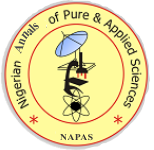Evaluation of Crude Pectin Obtained From Green Citrus Peels Of Sweet Orange (Citrus Sinesis) Grape (Citrus Paradisi) and Lime (Citrus Acida)
Keywords:
Pectin, Citrus peels, Agricultural wastesAbstract
Crude pectin was extracted from the peels of sweet orange (Citrus sinesis), grape (Citrus paradisi) and lime (Citrus acida), using the hot water bath procedure. Varying extraction conditions one at a
time, a maximum yield of 26 % was obtained from Citrus sinesis. Optimum conditions for the process were established to be pH of 1.5, temperature of 80 oC and time 60 minutes. Qualitative and quantitative analyses showed that the pectin from these three sources were the same in color and texture. They were all soluble in hot alkali and water. The moisture content, ash content and methoxyl
content, were all higher in the pectin extracted from C. sinesis and had the values 7.6, 9.80, 4.717 respectively. However, the equivalent weight of the pectin extracted from the peels of lim was higher
with 684.9 mg/mol. The total anhydrouronic acid content and degree of esterification were also calculated using the equivalent and methoxyl content gotten. The overall results point towards the
amenability of the extracted pectin for industrial applications
References
Belkheiri, A., Forouhar, A., Ursu, A.V., Dubessay, P., Pierre, G., Delattre, C., Djelveh, G., Abdelkafi, S., Hamdami, N., Michaud, P. (2021). Extraction, Characterization, and Applications of Pectins from Plant By-Products. Appl. Sci. 11, 6596
Devi, W. E., Shukla, R.N., Bala, K L., Kumar, A., Mishra, A.A. andYadav, K C. (2014). Extraction of Pectin from Citrus Fruit Peel and Its Utilization in Preparation of Jelly, International Journal of Engineering Research & Technology (IJERT). 3(5), pp.1925-1932
Dranca, F., Oroian, M. (2018). Extraction, purification and characterization of pectin from alternative sources with potential technological applications. Food Res. Int. 113, 327–350.
Gama, B. M. V., Silva, C. E. F., Silva, L. M. O., Abud, A. K. S. (2015). Extraction and Characterization of Pectin from Citric Waste, Chemical Engineering Transactions 44:3-4.
Georgiev, Y., Ognyanov, M., Kussovski, V. and Kratchanova, M. (2012). Isolation, characterization and modification of citrus pectins. Journal of Bioscience and Biotechnology, 1(3): 223-233.
Hwang, J., Pyun, Y.R. and Kokini, J.I. (1993). Side chains of pectins: Some thoughts on their role in plant cell walls. Food Hydrocolloids, 7: 3.
Ismail, N.S.M., Ramli, N., Hani, N.M. andMeon, Z. (2012). Extraction and characterization of pectin from dragon fruit (Hylocereus polyrhizus) using various extraction conditions. Sains Malaysiana, 41: 41-45
Maric, M., Grassino, A.N., Zhu, Z., Barba, F.J., Brn¡ci´c, M., Brn¡ci´c, S.R. (2018). An overview of the traditional and innovative approaches for pectin extraction from plant food wastes and by-products: Ultrasound-, microwaves- , and enzyme-assisted extraction. Trends Food Sci. Technol. 76, 28–37.
McGready, R.M., (1996). Extraction of Pectin from Citrus Peels and Conversion of Pectin Acid. 2nd Edn., Academic Press, New York, 4: 167-170.
Mohamed, S. and Hassan, Z. (1995). Extraction and characterization of pectin from various tropical agrowastes. ASEAN Food Journal, 2: 43-50.
Muhamadzadeh, J., Sadghi-Mahoonak, A.R., Yaghbani, M., Aalam, M. (2010). Extraction of Pectin from Sunflower Head Residues of Selected Iranian Cultivars, World Applied Science Journal, 8: 21-24.
Naqash, F., Masoodi, F., Rather, S.A., Wani,c S., Gani, A. (2017). Emerging concepts in the nutraceutical and functional properties of pectin—A Review. Carbohydr. Polym. 168, 227–239.
Nasseri, A.T., Thibault, J.F and Ralet, M.C. (2008). Citrus pectin: Structure and application in Acid Dairy Drinks, Tree and Forestry Science and biotechnology, 2(Special issue 1), 60-70.
Owens, H.S., McCroady, R.M., Shepherd, A.D., Schultz, T.H., Pippen, E.L., Swenson, H.A., Miers, J.C., Erlandsen, R. F., Maclay, W.D. (1952). Methods used at Western Regional Research Laboratory for extraction of pectic materials. Bureau of Agricultural and Industrial Chemistry, Agricultural Research Administration, U.S department of Agriculture
Pi, F., Liu, Z., Guo, X., Guo, X., Meng, H. (2019). Chicory root pulp pectin as an emulsifier as compared to sugar beet pectin. Part 1: Influence of structure, concentration, counterion concentration. Food Hydrocoll. 89, 792– 801.
Picot-Allain, M.C.N., Ramasawmy, B., Emmambux, M.N. (2020). Extraction, characterisation, and application of pectin from tropical and sub-tropical fruits: A review. Food Rev. Int. 1–31.
Ranganna, S. (1995). Hand book of analysis and quality control for fruits and vegetable products (2nd Ed.). New Delhi: McGrawHill publishing Co. Ltd. 33- 43.
Specifications and criteria for identity and purity of some flavouring substances and non-nutritive sweetening agents. FAO Nutrition Meetings Report Series, No. 44B, 1969; WHO/Food Add/69.31.
Thakur, B.R., Singh, R. K and Handa, A. K. (1997). Chemistry and Uses of PectinA Review, Critical Reviews in Food Science and Nutrition, 37(l):47-7
Downloads
Published
How to Cite
Issue
Section
License
Copyright (c) 2023 R. E. Kukwa, F.T. Samoh, D. T. Kukwa, L Ochefu

This work is licensed under a Creative Commons Attribution-ShareAlike 4.0 International License.



 Contact Us
Contact Us Editorial Team
Editorial Team Join As A Reviewer
Join As A Reviewer  Request For Print Copy
Request For Print Copy


 Cprint Publishers
Cprint Publishers